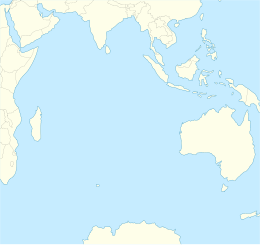
Back جغرافيا سريلانكا Arabic Xeografía de Sri Lanka AST Şri-Lanka coğrafiyası Azerbaijani География на Шри Ланка Bulgarian শ্রীলঙ্কার ভূগোল Bengali/Bangla Geografía de Sri Lanka Spanish جغرافیای سریلانکا Persian Sri Lankan maantiede Finnish Géographie du Sri Lanka French श्रीलंका का भूगोल Hindi
Nickname: Pearl of the Indian Ocean | |
|---|---|
Map Sri Lanka | |
| Geography | |
| Location | Indian Ocean |
| Coordinates | 7°N 81°E / 7°N 81°E |
| Area | 65,612 km2 (25,333 sq mi) |
| Coastline | 1,785 km (1109.1 mi) |
| Highest elevation | 2,524.13 m (8281.27 ft) |
| Highest point | Pidurutalagala |
| Administration | |
| Largest settlement | Colombo (pop. 752,993) |
| Demographics | |
| Population | 20,277,597 (2012) |
| Pop. density | 323/km2 (837/sq mi) |
| Ethnic groups | Sinhalese – 75%, Sri Lanka Tamils – 16%, Sri Lankan Moors – 9% |

Sri Lanka, formerly called Ceylon, is an island nation in the Indian Ocean, southeast of the Indian subcontinent, in a strategic location near major sea lanes.[1] The nation has a total area of 65,610 square kilometres (25,330 sq mi), with 64,630 square kilometres (24,950 sq mi) of land and 980 square kilometres (380 sq mi) of water.[1] Its coastline is 1,340 kilometres (830 mi) long.[1] The main island of Sri Lanka has an area of 64, 058 km2; it is the twenty-fifth largest island in the world by area.[2] Dozens of offshore islands account for the remaining 1552 km2 area.[3] The largest offshore island, Jaffna Island is separated by Chundikulam lagoon and Mannar Island, is linked to Adam's Bridge, a land connection to the Indian mainland, which is now mostly submerged with only a chain of limestone shoals remaining above sea level. According to temple records, this natural causeway was formerly whole, but was breached by a violent storm (probably a cyclone) in 1480.[4] The formation is also known as Rama's Bridge, as according to Hindu mythology, it was constructed during the rule of Lord Rama.[5]
Sri Lanka's climate includes tropical monsoons; the northeast monsoon (December to March), and the southwest monsoon (June to October).[1] Its terrain is mostly low, flat to rolling plain, with the mountainous upcountry in the south-central interior.[1] The highest point is Pidurutalagala at 2,524 m (8,281 ft).[1] Natural resources include limestone, graphite, mineral sands, gems, phosphates, and clay.
- ^ a b c d e f "Sri Lanka". The World Factbook. Central Intelligence Agency. May 11, 2021. Retrieved May 14, 2021.
 This article incorporates text from this source, which is in the public domain.
This article incorporates text from this source, which is in the public domain.{{cite web}}: CS1 maint: postscript (link) - ^ "Joshua Calder's World Island Info – Largest Islands of the World". Worldislandinfo.com. Retrieved 2016-01-30.[unreliable source?]
{{cite web}}: CS1 maint: postscript (link) - ^ www.jpp.co.jp https://www.jpp.co.jp/lanka/geo/geote/geo05e.htm. Retrieved 2023-04-14.
{{cite web}}: Missing or empty|title=(help) - ^ Manimaran, G. (2008-08-01). "Geoenvironmental Scenario on the Landward Migration of Thamiraparani Microlithic Culture to Sri Lanka Through Adam's Bridge". Journal of the Geological Society of India. 72: 222–224..
- ^ "Adam's bridge". Encyclopædia Britannica. 2007. Archived from the original on 13 January 2008. Retrieved 14 September 2007.

